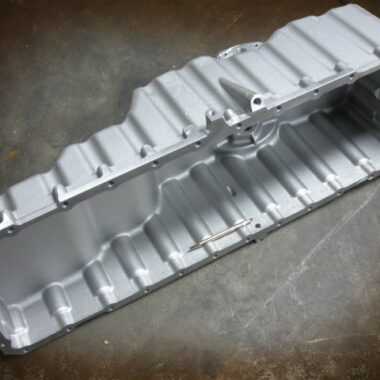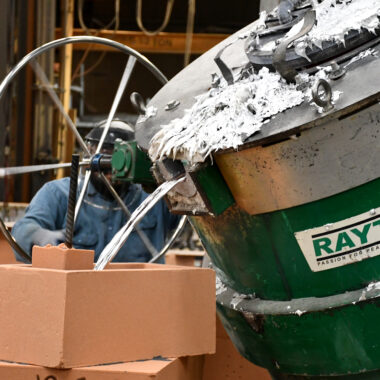About Aluminum Casting Chronicles: Strategies, Patterns, and Tips
About Aluminum Casting Chronicles: Strategies, Patterns, and Tips
Blog Article
Check Out the World of Light Weight Aluminum Spreading: Expert Strategies and tricks
In the realm of manufacturing, aluminum casting stands as a pivotal procedure, crucial for the production of a large variety of products. As we browse via the world of aluminum spreading, there exists a realm of expert secrets and approaches that can boost the top quality of the final products and streamline the production process.

The Basics of Aluminum Casting
Aluminum spreading, a basic process in production, entails the pouring of molten light weight aluminum right into a mold to accomplish desired structures and shapes. This flexible technique is extensively used throughout numerous sectors due to aluminum's phenomenal buildings such as high strength-to-weight proportion, deterioration resistance, and thermal conductivity.
The process starts with the melting of light weight aluminum in a heater at temperature levels surpassing 1220 ° F(660 ° C ) Once the aluminum reaches its liquid state, it is put into a pre-designed mold dental caries. The mold, generally made from products like steel or sand, identifies the last form of the cast light weight aluminum part.
After putting, the aluminum is delegated cool and strengthen within the mold - about aluminum casting. This cooling period is essential as it figures out the stability and quality of the end product. As soon as strengthened, the mold is gotten rid of, disclosing the newly developed light weight aluminum casting
Insider Tips for Effective Casting
To attain ideal lead to aluminum spreading, careful focus to information throughout the mold and mildew design phase is necessary for ensuring effective end results. One insider suggestion for successful casting is to carefully consider the gating system. The style of the gating system plays a crucial role in managing the circulation of liquified light weight aluminum right into the mold and mildew dental caries, ensuring appropriate dental filling and reducing flaws like air entrapment. In addition, keeping the right metal temperature is important for achieving high-grade spreadings. Monitoring and managing the metal temperature level throughout the casting procedure can help protect against concerns such as premature solidification or porosity in the last product.
A well-prepared mold and mildew surface area can contribute to much better steel circulation, minimized turbulence, and improved surface finish on the actors part. By paying close interest to these expert suggestions, manufacturers can improve the quality and performance of their light weight aluminum casting procedures.
Advanced Techniques in Light Weight Aluminum Spreading
Using ingenious techniques and innovative techniques, the world of aluminum casting has seen a significant advancement in the direction of advanced techniques that push the borders of conventional methods. One such method is vacuum spreading, which involves creating a vacuum cleaner environment to get rid of air from the mold and mildew tooth cavity, leading to better and more detailed spreadings with minimized porosity. In addition, investment casting, also known as lost-wax spreading, is a polished technique that enables slim walls and complicated shapes, leading to accurate and comprehensive aluminum components.

Moreover, advanced simulation software plays a vital role in enhancing spreading layouts and here anticipating prospective issues, permitting modifications to be made prior to the real spreading process begins. By welcoming these sophisticated methods, manufacturers can elevate their aluminum casting abilities to new heights, fulfilling the needs of contemporary sectors with accuracy and advancement.
Recognizing Different Casting Techniques
In the world of production, a detailed understanding of different casting methods is crucial for attaining ideal cause metal fabrication procedures. Different spreading techniques use one-of-a-kind advantages and are chosen based on variables such as the complexity of the design, manufacturing volume, material requirements, and price factors to consider. Among one of the most usual casting approaches is sand spreading, where a mold and mildew is produced using sand as the main material. Sand spreading is functional, affordable, and appropriate for generating huge parts.
An additional prominent why not look here spreading method is die spreading, which entails injecting liquified metal right into a mold and mildew tooth cavity under high pressure. Die casting is understood for its high precision, smooth surface area coating, and the capability to generate complex forms with tight resistances. Gravity spreading, on the other hand, relies upon gravity to fill the mold and mildew dental caries Find Out More with molten metal. This method appropriates for creating easier shapes and is cost-efficient for tiny to tool manufacturing runs. By understanding the subtleties of various spreading methods, manufacturers can make enlightened choices to maximize their production procedures and achieve the desired outcomes.
Optimizing Performance in Spreading Operations
With a firm understanding of the subtleties of various casting methods, suppliers can streamline their procedures to improve effectiveness in steel manufacture procedures. Optimizing effectiveness in casting operations needs an organized approach that focuses on maximizing every action of the casting process.
In addition, purchasing sophisticated technology and devices can dramatically enhance performance in casting procedures. Automated systems, robotics, and computer-aided design (CAD) software application can enhance processes, reduce errors, and rise result. In addition, training staff members on the current techniques and best practices can additionally add to making best use of efficiency in casting operations.
Routine upkeep of tools and devices is important to decrease and stop break downs downtime - about aluminum casting. Implementing an aggressive maintenance timetable can assist identify possible issues before they rise, making sure smooth operations and nonstop manufacturing. Overall, by focusing on effectiveness and continual enhancement, manufacturers can enhance their casting procedures and stay affordable in the industry

Final Thought
Finally, the world of aluminum spreading supplies a variety of possibilities for those seeking to produce resilient and intricate steel things. By grasping the fundamentals, utilizing expert pointers, and checking out sophisticated techniques, people can accomplish terrific success in their casting undertakings. Recognizing the different casting approaches and enhancing efficiency in procedures are crucial components to attaining top notch lead to aluminum spreading. With dedication and technique, one can genuinely unlock the possibility of this versatile metalworking procedure.
One such technique is vacuum cleaner casting, which entails creating a vacuum atmosphere to remove air from the mold dental caries, leading to higher high quality and more detailed castings with reduced porosity (about aluminum casting). In addition, investment casting, likewise recognized as lost-wax casting, is a refined technique that permits for slim walls and complicated forms, resulting in specific and detailed light weight aluminum parts
One of the most common casting techniques is sand spreading, where a mold and mildew is developed using sand as the primary material.One more prominent spreading approach is pass away spreading, which entails infusing molten metal into a mold cavity under high pressure. Understanding the different casting techniques and enhancing effectiveness in operations are crucial elements to accomplishing high-grade outcomes in light weight aluminum spreading.
Report this page